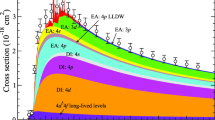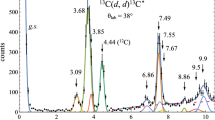Abstract
In this paper, the contribution of many-body effects to the X-ray photoelectron spectroscopy, XPS, of an NO molecule is studied using wavefunction theory where the specific consequences of different many-body terms are examined and contrasted. It is shown that there is a differential importance of the many-body effects for the different configurations involved in the XPS. These are the ground, initial state configuration and final, N(1s) and O(1s) core hole ionic configurations. The consequences of the many-body effects are examined for the binding energies, BEs, to the two final state multiplets, triplet, and singlet, for each of the core ions and for the relative intensities of the XPS transitions to these multiplets. The many-body effects examined are those described as static effects that arise for individual terms that are important. The objective is to understand the chemical and physical origins that determine the importance of the correlation effects for the XPS, rather than to obtain very accurate predictions of the BEs. An important theoretical construct that is tested and justified is the equivalent core approximation where the core-ionized atom is replaced by the next higher element in the periodic table. This construct allows us to establish a correlation for the relative importance of the many-body effects in terms of effective charges of the different atoms. This is a correlation that has not been considered before and that we expect may have general relevance. The potential of the effects that we have identified for the XPS of NO to be relevant for the XPS of more complex, condensed phase systems is considered.
Similar content being viewed by others
Notes
CLIPS is a program system to compute ab initio SCF and correlated wavefunctions for polyatomic systems. It has been developed based on the publicly available programs in the ALCHEMY package from the IBM San Jose Research Laboratory by Bagus P S, Liu B, McLean A D and Yoshimine M.
References
Siegbahn K, Nordling C, Johansson G, Hedman J, Hedén PF, Hamrin K, Gelius U, Bergmark T, Werme LO, Manne R, Baer Y (1969) ESCA-applied to free molecules. North-Holland, Amsterdam
Siegbahn K, Nordling C, Fahlman A, Nordberg R, Hamrin K, Hedman J, Johansson G, Bergmark T, Karlsson SE, Lindgren I, Lindberg B (1967) ESCA-atomic, molecular, and solid state structure studied by means of electron spectroscopy. Almqvist and Wiksells, Uppsala
Bagus PS (1965) Self-consistent-field wave functions for hole states of some Ne-like and Ar-like ions. Phys Rev 139:A619
Pueyo Bellafont N, Bagus PS, Illas F (2015) Prediction of core level binding energies in density functional theory: rigorous definition of initial and final state contributions and implications on the physical meaning of Kohn–Sham energies. J Chem Phys 142:214102
Bagus PS, Ilton ES, Nelin CJ (2013) The interpretation of XPS spectra: insights into materials properties. Surf Sci Rep 68:273
Bagus PS, Ilton ES, Nelin CJ (2018) Extracting chemical information from XPS spectra: a perspective. Catal Lett 148:1785
Gupta RP, Sen SK (1975) Calculation of multiplet structure of core p-vacancy levels. II. Phys Rev B 12:15
Gupta RP, Sen SK (1974) Calculation of multiplet structure of core p-vacancy levels. Phys Rev B 10:71
Bagus PS, Freeman AJ, Sasaki F (1973) Prediction of new multiplet structure in photoemission experiments. Phys Rev Lett 30:850
Bagus PS, Broer R, Ilton ES (2004) A new near degeneracy effect for photoemission in transition metals. Chem Phys Lett 394:150
Valderrama E, Ludena EV, Hinze J (1999) Assessment of dynamical and nondynamical correlation energy components for the beryllium-atom isoelectronic sequence. J Chem Phys 110:2343
Knowles P, Schütz M, Werner H-J (2000) In: Grotendorst J (ed) Ab initio methods for electron correlation in molecules in modern methods and algorthms of quantum chemistry, vol 3. John von Neumann Institute for Computing, Jülich, p 97
Bagus PS, Broer R, Parmigiani F (2006) Anomalous electron correlation due to near degeneracy effects: low-lying ionic states of Ne and Ar. Chem Phys Lett 421:148
Bagus PS, Sousa C, Illas F (2016) Consequences of electron correlation for XPS binding energies: representative case for C(1s) and O(1s) XPS of CO. J Chem Phys 145:144303
Mulliken RS (1949) J Chim Phys 46:497
Bagus PS, Schrenk M, Davis DW, Shirley DA (1974) Anomalous multiplet-splitting intensity ratios in K-level X-ray photoemission. Phys Rev A 9:1090
Koepke JW, Jolly WL (1976) The core electron binding energies of oxygen difluoride. J Electron Spectrosc Relat Phenom 9:413
Jolly WL (1972) The estimation of core-electron binding-energy shifts using the concept of the equivalence of equally charged cores. In: Shirley DA (ed) Proceedings of the international conference on electron spectroscopy. North-Holland, Amsterdam, p 629
Viñes F, Sousa C, Illas F (2018) On the prediction of core level binding energies in molecules, surfaces and solids. Phys Chem Chem Phys 20:8403
Roos BO, Taylor PR, Siegbahn PEM (1980) A complete active space SCF method (CASSCF) using a density matrix formulated super-CI approach. Chem Phys 48:157
Manne R, Åberg T (1970) Koopmans’ theorem for inner-shell ionization. Chem Phys Lett 7:282
Aberg T (1967) Theory of X-ray satellites. Phys Rev 156:35
Levine IN (2000) Quantum chemistry. Prentice-Hall, Upper Saddle River, NJ
Bagus PS, Schaefer HF (1971) Direct near-Hartree–Fock calculations on the 1s hole states of NO+. J Chem Phys 55:1474
Clementi E, Roothaan CCJ, Yoshimine M (1962) Accurate analytical self-consistent field functions for atoms. II. Lowest configurations of the neutral first row atoms. Phys Rev 127:1618
Huber KP, Herzberg G (1979) Molecular spectra and molecular structure, vol 4, constants of diatomic molecules, vol 4. Van Nostrand, New York
Löwdin PO (1975) Quantum theory of many-particle systems. I. Physical interpretations by means of density matrices, natural spin-orbitals, and convergence problems in the method of configurational interaction. Phys Rev 97:1474
Prosser F, Hagstrom S (1968) Correspponding orbitals and cofactors. J Chem Phys 48:4807
Partridge H (1989) Near Hartree–Fock quality GTO basis sets for the first- and third-row atoms. J Chem Phys 90:1043
Duijneveldt FB (1971) IBM Internal Report RJ945
Pueyo Bellafont N, Illas F, Bagus PS (2015) Validation of Koopmans’ theorem for density functional theory binding energies. Phys Chem Chem Phys 17:4015
Bagus PS, Ilton ES (2006) Effects of covalency on the p-shell photoemission of transition metals: MnO. Phys Rev B 73:155110
de Graaf C, Sousa C, Broer R (1999) Ionization and excitation energies in CuCl and NiO within different embedding schemes. J Mol Struc THEOCHEM 458:53
Acknowledgements
PSB acknowledge support from the U.S. Department of Energy, Office of Science, Office of Basic Energy Sciences, Chemical Sciences, Geosciences, and Biosciences (CSGB) Division through the Geosciences program at Pacific Northwest National Laboratory. CS and FI have been supported by the Spanish MINECO/FEDER through CTQ-2015-64618-R and Excellence María de Maeztu program MDM-2017-0767 grants and, in part, by Generalitat de Catalunya Grants 2014SGR97 and XRQTC. F.I. acknowledges additional support from the 2015 ICREA Academia Award for Excellence in University Research.
Author information
Authors and Affiliations
Corresponding author
Additional information
Dedicated to Prof. Jean Paul Malrieu on occasion of his 80th birthday.
Publisher's Note
Springer Nature remains neutral with regard to jurisdictional claims in published maps and institutional affiliations.
Published as part of the special collection of articles derived from the 11th Congress on Electronic Structure: Principles and Applications (ESPA-2018).
Electronic supplementary material
Below is the link to the electronic supplementary material.
Rights and permissions
About this article
Cite this article
Bagus, P.S., Sousa, C. & Illas, F. Differential many-body effects for initial and core ionic states: impact on XPS spectra. Theor Chem Acc 138, 61 (2019). https://doi.org/10.1007/s00214-019-2450-1
Received:
Accepted:
Published:
DOI: https://doi.org/10.1007/s00214-019-2450-1




